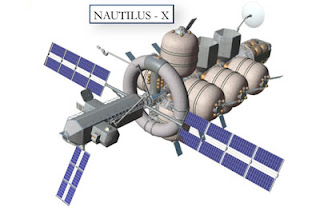The Completely False Choice
During an interview on The Space Show Jeff Greason described the Flexible Path as a pragmatic approach to human space exploration when considering NASA's limited budget. Towards the end he says:
The message here is that the Moon and Mars both require landers and it's hard enough just trying to get there with a limited budget. So, assuming NASA isn't going to get double as much money, it needs to find a way to do with what it's got. This is a fiscal reality. Those who say "Constellation can be fixed" or who say "I don't think landers are all that expensive" are simply in denial.
If we choose to delay building a lander, we free up the funding to focus on interplanetary cruise capability - that is, sending astronauts beyond the Earth-Moon system and returning them safely. Where exactly the astronauts visit while they're "out in the black" is kinda irrelevant.
Yes, they can visit the Sun-Earth Lagrange points and do servicing on sun observing satellites. Yes, they can go to asteroids and do scientific investigation that may help deflect a threat to Earth one day. Yes, they can go to the moons of Mars and do more science. Yes, all this will engage the public and inspire kids to study science, technology, engineering and math. But these are just nice benefits.
The real goal is to demonstrate that the spacecraft can take us anywhere we want to go and, in particular, that it can take us to the future home(s) of humanity.
During this development process NASA's robotic exploration program will continue. Including exciting missions to the Moon to demonstrate the kind of teleoperated robotic vehicles that will be operated on the Mars surface by astronauts in Mars orbit - perhaps to do a sample return mission.
Later, the required landers can be developed so they are safe, refuel-able and re-usable. They can stay permanently at their destination - Moon or Mars - so we don't have to carry them backwards and forwards to Earth every trip. NASA will be economically free to build infrastructure to encourage the commercial delivery of that fuel from where-ever it makes sense: Earth, the Lunar surface or the Mars atmosphere.
Eventually the NASA demonstrations will give way to commercial activity. The economic sphere of influence will expand into deep space. Space-based solar power and asteroid mining will seem inevitable when a solar-electric propulsion vehicle can take astronauts to visit an asteroid as a mere stepping stone to greater things.
Colonization of the inner solar system will surely follow.
The question is not "do we or don't we go to the Moon", that's a completely false choice. The question is do we structure the program, for the same money, in a way in which - in addition to going back to the Moon - we get asteroids, Lagrange points, maybe a Mars flyby, and we build up deep space experience that we're going to need for Mars, instead of waiting 20 years and hoping that the public's enthusiasm can be sustained.
The message here is that the Moon and Mars both require landers and it's hard enough just trying to get there with a limited budget. So, assuming NASA isn't going to get double as much money, it needs to find a way to do with what it's got. This is a fiscal reality. Those who say "Constellation can be fixed" or who say "I don't think landers are all that expensive" are simply in denial.
If we choose to delay building a lander, we free up the funding to focus on interplanetary cruise capability - that is, sending astronauts beyond the Earth-Moon system and returning them safely. Where exactly the astronauts visit while they're "out in the black" is kinda irrelevant.
Yes, they can visit the Sun-Earth Lagrange points and do servicing on sun observing satellites. Yes, they can go to asteroids and do scientific investigation that may help deflect a threat to Earth one day. Yes, they can go to the moons of Mars and do more science. Yes, all this will engage the public and inspire kids to study science, technology, engineering and math. But these are just nice benefits.
The real goal is to demonstrate that the spacecraft can take us anywhere we want to go and, in particular, that it can take us to the future home(s) of humanity.
During this development process NASA's robotic exploration program will continue. Including exciting missions to the Moon to demonstrate the kind of teleoperated robotic vehicles that will be operated on the Mars surface by astronauts in Mars orbit - perhaps to do a sample return mission.
Later, the required landers can be developed so they are safe, refuel-able and re-usable. They can stay permanently at their destination - Moon or Mars - so we don't have to carry them backwards and forwards to Earth every trip. NASA will be economically free to build infrastructure to encourage the commercial delivery of that fuel from where-ever it makes sense: Earth, the Lunar surface or the Mars atmosphere.
Eventually the NASA demonstrations will give way to commercial activity. The economic sphere of influence will expand into deep space. Space-based solar power and asteroid mining will seem inevitable when a solar-electric propulsion vehicle can take astronauts to visit an asteroid as a mere stepping stone to greater things.
Colonization of the inner solar system will surely follow.


Comments
Post a Comment